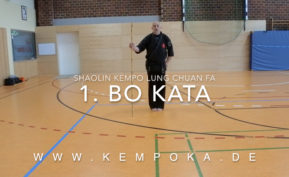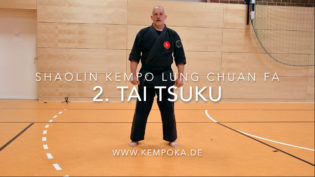The long pole, Bo (Japanese) or Gun (Chinese) is the first and central weapon taught in Lung Chuan Fa. Probably only the stone in the hand is older when it comes to the use of tools in combat. However, we do not throw or hit with stones, so we devote ourselves to the wooden everyday object. You can also find the sequences on YouTube, the links are in the text.
I have already commented on the hardware here, this time it’s about the handling. In Lung Chuan Fa we practice (currently) three forms with the Bo. Since I have made a more intensive excursion into the world of the Japanese/okinawan world of the Bo, the difference in the handling of the long weapon is obvious. The Japanese bo is held almost exclusively in the one-third grip, rarely varying the grip position. In Shaolin Kempo, on the other hand, we try to utilize the full length of the stick. The Bo is often brought into rotation. If this is then combined with our footwork and posture, we move very far away from Japanese styles.
However, the material of our bo is usually rattan, bamboo or hardwood. And much thicker and therefore heavier than in many Chinese styles. Here we stick to Japanese dimensions. As a result, we can’t make the bo turn quite as fast as wushu fighters do. Or as demonstrated above all by the American “tricking” experts, who use sticks made of carbon or light wood and not only pirouette with them, but even throw their sports equipment into the air.
2 + 1 Kata
 Our 1st Bo kata is a typical beginner kata. After the greeting, four equal movement sequences follow, which are executed one after the other in the four cardinal directions. 90- and 180-degree turns alternate. At the end follows a final closing technique, with which the last of the imaginary opponents is transported to his ancestors with a powerful thrust. In the beginning, the rotating bo and the 180-degree turns are the challenge to the practitioner. And the condition, because the handling of the long weapon requires strength and endurance. Who wants to take the green belt, must remember and execute the 30 movements.
Our 1st Bo kata is a typical beginner kata. After the greeting, four equal movement sequences follow, which are executed one after the other in the four cardinal directions. 90- and 180-degree turns alternate. At the end follows a final closing technique, with which the last of the imaginary opponents is transported to his ancestors with a powerful thrust. In the beginning, the rotating bo and the 180-degree turns are the challenge to the practitioner. And the condition, because the handling of the long weapon requires strength and endurance. Who wants to take the green belt, must remember and execute the 30 movements.
 The 2nd Bo Kata is also our longest and most difficult. The beginning is almost the same as the 1st Bo-Kata, but after that beautiful and beautifully difficult movement sequences follow. The kata is much longer than the 1st Bo-Kata, contains some really challenging passages and elements that clearly remind of Chinese Kuen. Changes behind the back, attacks to the ankles, strikes to the head – if you want to master this board, you have to practice again and again and hone individual elements. Control is very important, over one’s own stance as well as over the weapon. And it does not work without strength, which is why the Kata is not for children. From the blue belt the 2nd Bo-Kata belongs to the examination program, it is practiced from the green belt.
The 2nd Bo Kata is also our longest and most difficult. The beginning is almost the same as the 1st Bo-Kata, but after that beautiful and beautifully difficult movement sequences follow. The kata is much longer than the 1st Bo-Kata, contains some really challenging passages and elements that clearly remind of Chinese Kuen. Changes behind the back, attacks to the ankles, strikes to the head – if you want to master this board, you have to practice again and again and hone individual elements. Control is very important, over one’s own stance as well as over the weapon. And it does not work without strength, which is why the Kata is not for children. From the blue belt the 2nd Bo-Kata belongs to the examination program, it is practiced from the green belt.
 The 3rd Bo kata is a little out of the ordinary, because its movements follow a different pattern. No wonder, because it was once launched by the group around Grandmaster Cor Brugman as a pure practice kata. Sifu Olaf: “At that time we thought about how to make the first movements with the Bo easier for the beginners. And started to run the 1st Sifat with the Bo. Years later I was totally amazed when I saw that Kempoka ran this exercise as a real kata.” The step sequences are identical to Sifat Pertama, the 1st Sifat. And the stick techniques also mimic the use of the hands. A nice example of how useful it can be to run your kata with weapons sometimes. This works almost always …
The 3rd Bo kata is a little out of the ordinary, because its movements follow a different pattern. No wonder, because it was once launched by the group around Grandmaster Cor Brugman as a pure practice kata. Sifu Olaf: “At that time we thought about how to make the first movements with the Bo easier for the beginners. And started to run the 1st Sifat with the Bo. Years later I was totally amazed when I saw that Kempoka ran this exercise as a real kata.” The step sequences are identical to Sifat Pertama, the 1st Sifat. And the stick techniques also mimic the use of the hands. A nice example of how useful it can be to run your kata with weapons sometimes. This works almost always …
5 = 1 Kata
Cue Sifu Olaf Bock: In the meantime we are learning five new Bo-Kata, which can be combined to one long form after the learning phase is finished. In these Bo-Kata the long pole follows even more the Shaolin Kempo movements. But more about that later …
In addition to the pure form runs, we also practice a two-part kumite, which is an agreed upon practice fight, with the Bo. This kind of exercise is important to understand the Bo as a weapon even better and to make the handling meaningful. Here it is important not only to execute clean techniques, but also to concentrate on the flow, otherwise the partner gets one on the paws. And that really hurts, even without great hardness in the blows …





